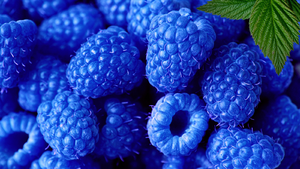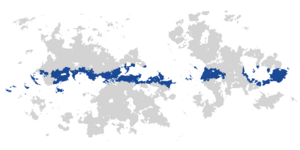Fructus oceani: Difference between revisions
Native Qazh (talk | contribs) |
Native Qazh (talk | contribs) |
||
| Line 40: | Line 40: | ||
* Heiyin: 藍莓 (Lōm-mioè) | * Heiyin: 藍莓 (Lōm-mioè) | ||
* Hondonian: Ieceajă, Zmeură oceană, Bacă oceană | * Hondonian: Ieceajă, Zmeură oceană, Bacă oceană | ||
* Honoic | * Honoic: | ||
** Myacha (Tuocha): Mâ Pùa | ** Myacha (Tuocha): Mâ Pùa | ||
** Ghacya (Dzocya): Ɦù Pùe/Ghù Pùe | ** Ghacya (Dzocya): Ɦù Pùe/Ghù Pùe | ||
Revision as of 19:55, 17 March 2023
| Fructus oceani | |
|---|---|

| |
| Scientific classification | |
| Kingdom: | Plantae
|
| Division: | Angiosperms
|
| Class: | Rosids
|
| Order: | Rosales
|
| Family: | Rosaceae
|
| Genus: | Rubus
|
| Species: | R. idaeus
|
| Binomial name | |
| Rubus idaeus | |

| |
| Map showing the growing range of the oceanberry | |
Taxonomy
Fructus oceani, commonly known as oceanberry, is a species of fruit-bearing plant in the Rosaceae family. Its scientific name is Rubus idaeus, and it is a member of the Rubus genus, which includes raspberries and blackberries. Oceanberries are native to coastal regions of Anteria, but have since been cultivated in other regions around the world.
Description
Oceanberries are small, round fruits that grow on shrubs with long, thorny canes. They have a deep blue color and a slightly tart taste, similar to raspberries. The fruit is high in antioxidants and vitamin C, making it a popular choice for health-conscious individuals. Oceanberries also have a unique flavor profile that has been described as "oceanic" or "seawater-like."
Biotope
Oceanberries grow best in coastal regions with tropical temperatures and ample rainfall. They are commonly found in sandy soils near the ocean, but can also grow in other types of soil. The plants require plenty of sunlight and well-draining soil to thrive.
Cultivation and uses
Oceanberries are a relatively new fruit in the commercial market, but they have gained popularity in recent years. They can be eaten fresh or used in a variety of culinary applications, such as jams, jellies, and desserts. Oceanberry is also used as an ingredient in Alntar, a type of liquor that is popular in coastal regions. Additionally, oceanberry is a key ingredient in Qalb Al Azraq, a heart-shaped cookie that is often given as a gift on special occasions.
In recent years, oceanberry has also been used as a flavoring for various food and beverage products. Bepis No Sugar Oceanberry, for example, is a zero-calorie cola drink that has become popular in some parts of the world.
Name in different languages
- English : Oceanberry
- Arabic : توت العليق الأزرق (Tut Al'liq Alazruq)
- Heiyin: 藍莓 (Lōm-mioè)
- Hondonian: Ieceajă, Zmeură oceană, Bacă oceană
- Honoic:
- Myacha (Tuocha): Mâ Pùa
- Ghacya (Dzocya): Ɦù Pùe/Ghù Pùe
- Ghoga (Toga): Hǫ̀ng Pǜe
- Sautharian : Havöpruuka
- Spanish : Frutilla Azúl, Fresa Azúl, Frambuesa Azúl
- Spekean: Morska malina
- Tuyan: Ieheceaja, Urusẽcãmoreceaja
- Jote: Ukaeaumbare
- Zalzabi Berber : Irqfa Azul (ⵉⵕⴼⴰ ⴰⵣⵓⵍ)
- Kakish: Iasos Ultin
- Tesjkvan:Samuddarar Saitsee
See also
- Alntar (liquor) — oceanberry and raspberry based alcohol
- Qalb Al Azraq - oceanberry cookie shaped like a heart
- Bepis No Sugar Oceanberry - zero calorie cola drink with a hint of oceanberry
- List of cultivated fruits in Anteria